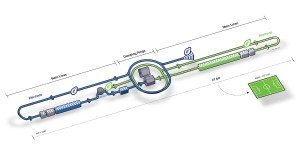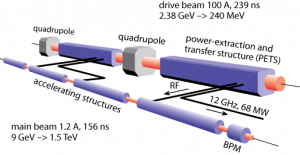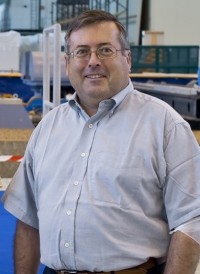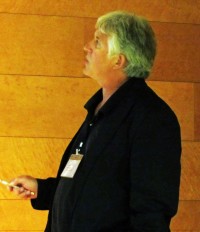
The International Linear Collider, based on superconducting radiofrequency technology. Image: ILC / form one visual communication
The International Linear Collider (ILC) is based on superconducting radiofrequency technology, while the Compact Linear Collider (CLIC) uses a two-beam acceleration concept. The ILC technique is more mature and the design more advanced: we are now putting together a detailed Technical Design Report that could serve as the basis of construction project. The CERN-based CLIC study still must demonstrate feasibility of the concept, and then the team will need to do systems demonstrations and develop a detailed machine design. So the timescale for CLIC is considerably longer. However, the CLIC energy reach is greater and that may be an important consideration. Meanwhile, the whole particle physics community awaits CERN’s Large Hadron Collider physics results, which we anticipate will justify a future linear collider, as well as guide the required parameters such as energy reach.
For several years, we have had a set of joint ILC/CLIC technical working groups that have served to exchange information, avoid duplication of effort and provide help to each other. In summer of 2010, we decided at a joint Global Design Effort (GDE) Executive Committee and CLIC Steering Committee meeting that it would be valuable to form an additional joint group to look at more general or strategic issues. Such issues could include agreed-upon points of comparison for the two approaches, determine what information is needed for making comparisons, and align dates and deliverables with expected decision points.
After some discussion inside the International Linear Collider Steering Committee (ILCSC) about the role and mandate for this “general issues” group, the concept was endorsed with the proviso that this particular working group report directly to ILCSC and to the CLIC Collaboration Board, their equivalent oversight committee. This General Issues Working Group released its first interim report a year ago and last month they released its second interim report. The ILC/CLIC General Issues Working Group membership is: Eckhard Elsen (DESY), Mike Harrison (BNL, co-chair), Philippe Lebrun (CERN, co-chair), Ken Peach (Oxford), Daniel Schulte (CERN) and Kaoru Yokoya (KEK).
The General Issues Working Group has met approximately monthly, and their first interim report concentrated on two elements of the charge:
- Identify synergies to enable the design concepts of ILC and CLIC to be prepared efficiently;
- Discuss plans for the ILC and CLIC efforts in order to identify common issues regarding siting, technical issues and project planning.
This first interim report contains a series of conclusions and recommendations.
Their first important conclusion came after reviewing the progress and plans of each joint working group. They concluded generally that “the common working groups have demonstrated their efficiency in tackling the technical challenges of a linear collider jointly.” We have built on this observation over the past year. For example, the joint ILC/CLIC detector group has contributed significantly to the recently released CLIC Physics and Detector Conceptual Design Report. Similarly, the joint ILC/CLIC Conventional Facilities Working Group is playing an important role towards that part of the ILC Technical Design Report (TDR).
Another important conclusion of the General Issues Working Group was that they “did not find the potential for cost savings in a phased approach to a linear collider compelling enough at this time to warrant any significant effort to investigate further.” This practical conclusion significantly reduces the number of options that we need to investigate.
Finally, an issue that was raised in the first interim report was the necessity of developing acceptable systems test programmes for each technology that would precede construction. Both groups have taken steps to address that issue, CLIC in their five-year R&D plan and the ILC GDE in their presentation last fall to the ILC Project Advisory Committee.
The second interim report focusses on two of the remaining charge items, specifically, elements of project implementation (siting and technical procurement strategy) and comments on the linear collider decision process. The recommendations and conclusions of the report are summarised below:
- The LC will be a jointly operated facility that will require appreciable infrastructure to host an international work team.
- The overall power requirements and energy management of a LC should be systematically examined and optimized so as to include efficient design of components and operation of the facility during its life cycle.
- Establish industrial architecture prior to launching procurement for each type of component, based on technical criticality, maturity of design, series numbers, quality assurance requirements, market structure and production follow-up capabilities.
- Develop cooperation with industry from early stages of the project, ensuring sufficient competition to be maintained throughout the procurement phase.
- Do not transfer to industrial suppliers technical responsibilities, which the project management is better placed to assess and to take.
- Maintain sufficient resources in the home laboratory to cope with tasks outside the capabilities or interest of industry, and to face unexpected technical, commercial or financial difficulties in the execution of the contracts.
- Following the anticipated regional reviews during 2012/3 on the state of particle physics in the light of the results from the first run of the LHC and other experimental and theoretical developments, and the strategic considerations that follow from them, the implications for the linear collider will need to be then assessed globally.
- Until the future of the linear collider program is more clearly established we recommend that no change be made to the successful joint WG operations.
The plan of the General Issues Working Group is to continue their work this coming year and to then issue one final report, which will “address points of comparison between the two approaches to the linear collider. Currently we envisage this to cover physics reach, accelerator technology, and cost and power estimates. In preparation for this report we are currently seeking input on the accelerator technology topic from the technical joint working groups. Additionally, we expect this analysis to provide recommendations for areas of joint efforts in the future.”
On behalf of the GDE, I can state that we find the recommendations of this joint working group to be thoughtful and follow sound project management principles. We welcome the recommendations and conclusions and believe that this has been a healthy and productive process. In particular, having an internal joint group of individuals from both CLIC and ILC working together on general issues that face moving a linear collider project ahead is a good step towards decision-making and consensus. I believe that both the ILC and CLIC are benefitting from looking together at issues that may well bear on the choice of what linear collider project goes forward.





Recent Comments